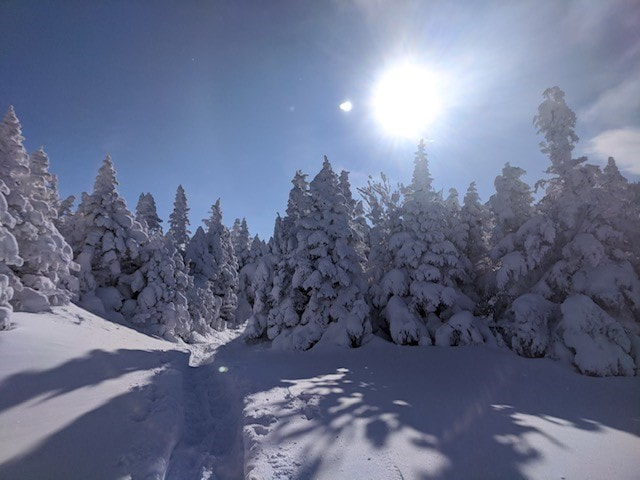 It's a new year and a new decade, a time for new beginnings and, with a nod to the number of the year we've entered, perhaps clearer vision of what we hope the coming time will bring. While we often think of Spring, with its plant life bursting forth, as a time of awakenings, Winter's shorter daylight hours and colder temperatures offers a time to retrench, restore, and rejuvenate, to collect one's energies and dive deeply into one's inner creativity. Indeed, writes the Italian poet Pietro Aretino, "Let us love winter, for it is the spring of genius." One also is reminded of T.S. Eliot's lines from The Wasteland: Winter kept us warm, covering Earth in forgetful snow, feeding A little life with dried tubers. While nature, with its withered stalks, may appear dormant in winter, there is a drawing inward that supports life and growth. Writes Gary Zukov, The winter solstice has always been special to me as a barren darkness that gives birth to a verdant future beyond imagination, a time of pain and withdrawal that produces something joyfully inconceivable, like a monarch butterfly masterfully extracting itself from the confines of its cocoon, bursting forth into unexpected glory. Allow yourself time during these wintry days to draw within, nurture, and replenish.
0 Comments
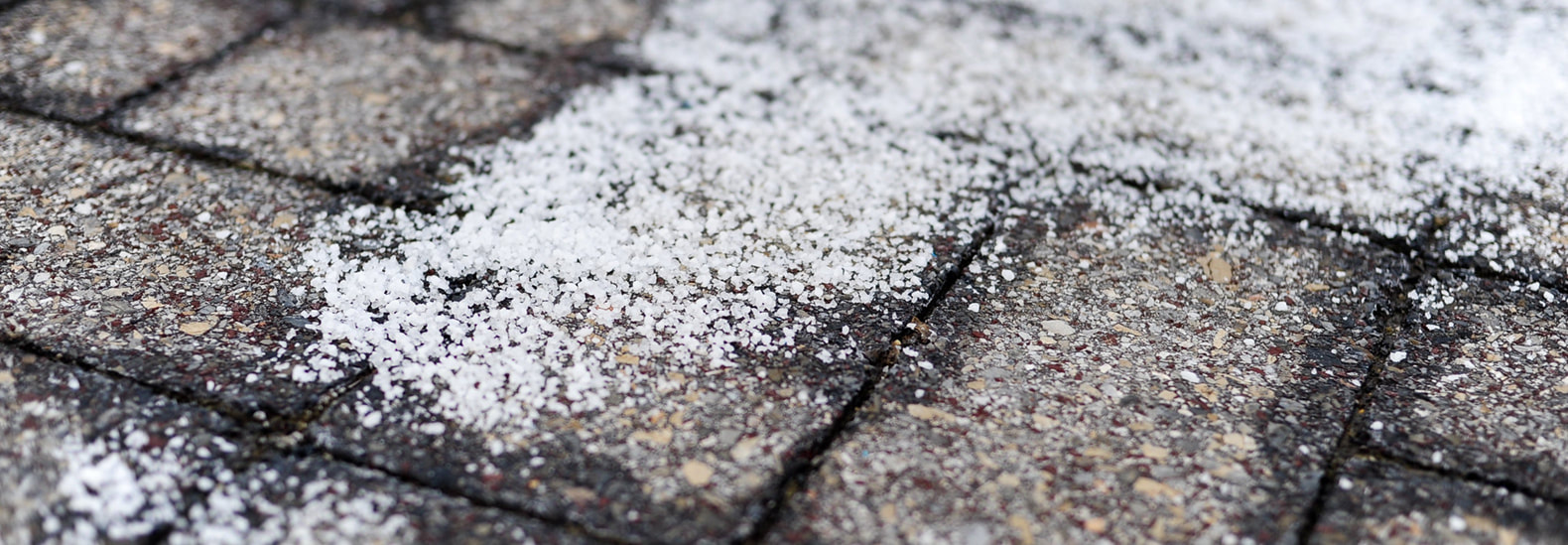 With the first snow storm of the season hitting New York City, out comes the salt, sprinkled on sidewalks and streets to reduce ice formation and slippery surfaces by lowering the freezing point of water. The salt, formed eons ago in the ocean, with chlorine derived from volcanoes at the bottom of the ocean combining with sodium washed off the continents, to form sodium chloride. Salt deposits are left behind by oceans that have dried up, and much of the salt spread on roads in the New York City area is shipped from deposits in the Atacama Desert in Chile. The volume of salt distributed on roads and sidewalks is staggering: 55 billion pounds are distributed on U.S. roads every year. It can be detected miles from where it is deposited, sixty floors above the city streets, and runs off into nearby waters, increasing their salinity. And it impacts living organisms. Chemically similar to potassium, salt it can work its way into the potassium-supported functions within cells. However, it cannot perform the processes powered by sodium, and thus is harmful to many organisms. Yet, as described by Menno Schilthuizen in Darwin Comes to Town, some living creatures have evolved in urban areas--that is, have genetically mutated--in ways that enable them to survive the road salt inundation of sodium. "Organisms that manage to cope with saline situations have usually evolved mechanisms to counteract the salty onslaught on their cells. [Thus, ...] salt-tolerant beach plants colonize the hard shoulders of major inland roads, pushing out the regular verge verdure. But chances are that the animals and plants that are already there also evolve salt tolerance thanks to road salting." Schilthuizen describes a lab experiment in which batches of small crustaceans--water fleas--were placed in tanks with different salt concentrations to live for 10 weeks (5-10 generations). The descendants were then removed from their salty environments, cultured for 3 additional generations in tanks of unsalted freshwater, and then tested for their salt tolerance. It turned out that "the water fleas retained the evolutionary signature of having adapted to salt water. When placed in brackish water...the strains that had lived under moderate salt concentrations ...survived well, whereas the ones previously naive to salinity experienced only 46 percent survival." Humans are transforming the environmental conditions of the places we inhabit; while harmful to many creatures, some creatures evolve to survive the harsh conditions we create.  Natural Areas Conservancy, a New York-based organization that works across the city to restore the city’s natural areas and to help New Yorkers discover the natural areas in their neighborhoods, recently hosted a symposium on “Forests in Cities: Nature-Based Climate Solutions”. A range of speakers, leaders from academia, non-profit organizations, and government, discussed the important yet undervalued ways of urban natural areas addressing climate change in cities is significant but has been traditionally undervalued. Discussed the following topics:
Among the key points raised were that more than 100 cities in the United States are managing forests, and 1.7 million acres in urban areas are natural areas, more than twice the acreage of Yosemite National Park. These areas play a critical role in climate change mitigation, including by sequestering carbon, cooling temperatures, and mitigating flooding and storm runoff. The carbon sequestered by trees in urban areas is the equivalent of the emissions of 500,000 cars per year. Essentially, they area an enormous carbon sink. The power of nature of provide climate solutions raises the question of how we will organize ourselves to leverage these benefits. Eighty-two percent of U.S. citizens live in cities. There is a need to mobilize around the issue of nature-based climate solutions. Yet, it can be challenging for people to care about nature if they have not experienced it. Thus, part of the change in the way we embrace nature as offering solutions needs to come from a change in people's relationship with nature. Natural Areas Conservancy has been a leader in restoring New York City's green areas and connecting urbanites with local natural areas and has been a significant voice supporting policies that benefit urban natural areas. One such initiative is the Climate Stewardship Act, which was introduced into Congress in September, 2019. If passed, the Act will fund the planting of 4.1 billion trees by 2030 and 16 billion trees by 2050. The trees would cover nearly 64 million acres and would capture more that two years of the U.S.'s greenhouse emissions, 13 billion metric tons of carbon dioxide, by the century's end. Four hundred million of these trees would be planted in urban areas, resulting in a cooling effect in the event of heatwaves and, in turn, a reduction in energy usage associated with air conditioning. Nature is at risk because of climate change--a nature offers solutions. 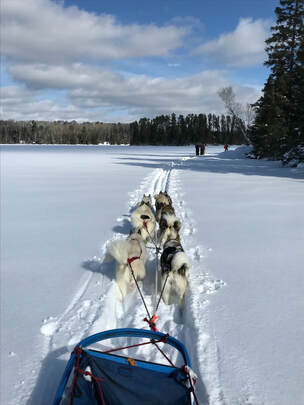 When the chill of winter arrives, you can either run the other way or embrace it. Having spent many years enjoying the outdoors in all seasons and weather, I aim for the latter and in this spirit spent the past week on a dog sledding and Nordic skiing camping trip in northern Minnesota. With temperatures well below zero and in the single digits, but also in the balmy teens, needs focus in on the basics: food and sufficient firewood with which to boil water and cook, the right clothing for staying warm and dry, and shelter-- in this case a bivvy sack for sleeping under the stars. The Boundary Waters are remote area that feels all the more remote in the winter. An area north of the "Laurentian Divide", raindrops and snow melt end up in the Arctic Ocean, rather than the Atlantic, Gulf of Mexico, or Pacific. Led by the fabulous outfitter Wintergreen, founded by Paul Schurke, a noted polar explorer whom we dubbed "Eighth Wonder of the Word" for his endurance, resilience, and intrepidness, the trip entailed traversing blissful miles of frozen lakes and boreal forests filled with black spruce and balsam furs, birch, and aspen. Along the way was evidence of local creatures -- snow tracks left by wolves, deer, moose, and snowshoe hares -- and continual admiration for our sled dogs, true professionals, each full of personality and eager to pull, dragging sleds carrying our heavy loads of equipment (with skiers breaking trail in the deeper snow). Inuit dogs are the domesticated breed closest to wolf; their wolfish selves emerging in their occasional canine-bearing snarls directed at one another to assert dominance. At the same time they respond like puppies when interacting with humans, basking in attention and rolling onto their backs for a stomach rub. In the remote frozen region, one's reliance on others becomes all the more apparent, an interesting irony in that one can feel most connected to other people in a wilderness environment. Arriving into the evening's campsite, we spread out to perform tasks assumed almost instinctually: gathering firewood, digging into the lake ice to create a water hole, setting up a fire pit on the ice, with a layer of logs underlying metal fire trays to separate the fire and ice. We cleared areas to set up our bivvy sacks, digging into the snow to shelter the bags from wind. And we tending to the sled dogs, transitioning them from the sled to hooking them up one by one on a line set up along the trees, removing their harnesses, and preparing their food. While the Boundary Waters are a world away from New York City, there was much that was elemental on the trip that translated to my urban home. If neighboring wolves and our sled dogs are pack animals, so too we humans form packs, finding community and interdependencies among one another, and even asserting--or encountering others asserting--alpha dominance. My return to New York City from the Great North Woods felt uncanny. The taxi that whisked me from the airport to home seemed confining and way to warm inside. To the driver's chagrin, I opened the window to feel the snap of cold and the breeze -- to breathe again -- and could almost imagine that I was being transported by dog sled across a frozen lake, rather than in a taxi on the crowded Grand Central Parkway. On arriving home, I took pleasure in having a warm bed and modern conveniences: indoor plumbing and a stove that didn't require gathering abundant firewood. At the same time that I appreciated the significant labor saved by these inventions, they also made me feel disconnected from the elemental features they deliver: fire at the turn of a knob; water at the turn of a handle. No hours spent scouring an island for firewood, with coordinated efforts to chop and saw fallen trees, drag them many yards to our fire pit and sort the wood into fire-starter twigs and birch bark, thicker branches, and logs. No continual chinking into the 2-foot lake ice to reach water. It all seemed too easy, and I pondered for a while what is lost when we receive such abundant resources with ease -- recognizing too how much is gained by not having to focus every day on basic survival needs. Having unpacked and run a load of laundry (more modern convenience magic!), I proceeded outside, ambling down Lexington Avenue, with each step sensing the breeze along the avenue as it touched the bare skin of my face and noting it felt as constant as the breeze encountered while traversing frozen lakes and forests on skis and dog sled. By some premonition, I felt a presence that impelled me to look up. And there, aloft on 73rd and Lex, was a Peregrine falcon, drifting on a thermal, a touch of wild in the metropolis, and a reminder of the wildness that persists if we just know where to look. 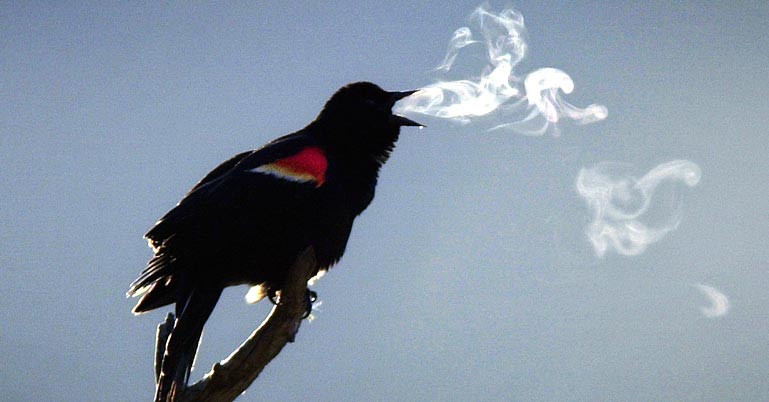 (c) Boston Globe (c) Boston Globe With temperatures in the New York City area in the single digits and teens over the past few days, a stroll outside can feel like an adventure. One of the more noticeable things about walking outside on a chilly day is that we can see our breath. With every exhale, a small cloud billows from our mouth, wisps whirling, clustering, separating and then fading into the surrounding air. From each living, breathing animal-being around us, cloudlets emanate with every breath, vaporous chiaroscuro intermingling with the exhales of passers by, as if engaging in a collective dance. Dogs on their outings and birds too display visible breath. Even the exhaust from cars and output from the tall chimney stacks on buildings become more visible, suggesting that in way they too are breathing, or that perhaps we living creatures have our own little engines. Indeed it is the oxygen we breathe in that fuels our bodies. We can live a month without food, a week without water, but only a few minutes without oxygen. Seeing our breath on a cold day is a reminder of our reciprocity with the natural world around us. The air we take in is 21% oxygen (78% is nitrogen) because of plants, which intake carbon dioxide and mix it with sunshine to create sugar and breathe out oxygen. We are taught in meditation to focus on our breath. How much easier it is to focus on breath when it becomes visible. And how much it reminds us of this minute by minute bodily process -- on average 16 breaths per minute -- that sustains our lives and the lives of others creatures around us.  The Central Park Lake The Central Park Lake With a number of days of below-freezing temperatures, ponds in the New York City area are beginning to ice over. Water that just a week ago responded to the subtlest of breezes begins to harden and solidify. The freezing starts on the edges of the pond, where the water is shallow, and crystallizes into a choreography of frozen formations: varying patterns and textures, spindle-like, smooth and pristine, rough and abraded, rivulets and cracks. The ice encases fallen leaves and twigs, a cryogenic embalming that delays their decomposition until the spring thaw. Infinite small bubbles gather below the frozen surface, and peering down through the ice at these glistening spheres seems not unlike gazing through a glass window at the starry night sky. They form a Milky-Way in aqueous suspension. Over the coming weeks, assuming the temperature frequents below freezing, the ice will grow toward the ponds' center, until the entire pond is frozen over. This icy sheath, H20 in its solid state, will separate the liquid world below, the realm of hibernating fish, turtles, and aquatic frogs, from the air above containing water in a gaseous state, including the moisture of our own breath, cloud-like and visible, and comingling with the chilly winter air. 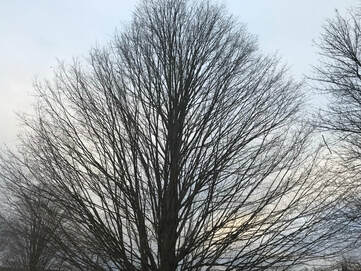 One of the blessings of winter is the opportunity to observe the architecture of hardwood trees. Shorn of concealing leaves, their framework becomes visible -- fractal geometry, with branches splitting off and again dividing and splitting, from the thick central trunk, a torso of sorts, culminating in finer twigs, like small fingers, reaching outward and upward. Each type of tree displays unique morphology and growth patterns, with limbs branching off at wider or narrower angles, sometimes looping downward in a "u" shape before ascending, some knobby, gnarled and twisted, others soaring, erect, and tapering, some with great symmetry, others more variable -- a range of templates for achieving growth and access to nourishing sunlight. The texture of trees' bark becomes more apparent in the crisp light of winter, the furrowed, patterned grooves of elms appear in greater relief, the smooth, silvery surface of beeches almost shines, and one senses the tactile feel of the scaly, thinly-plated bark of London Plane trees. Knots, burls, fissures, and cavities become visible. And amid the the muted winter palette, one can discern bark's varying colors, ranges of browns, grays, white, and green, sometimes with tinges of orange or red, colors often overshadowed by inviting greens and flamboyant autumn shades in the year's other seasons. And then there is the experience of striding past a stand of denuded trees, their trunks tall and aligned, like sentinels. With each step, a movement felt more keenly horizontal in relation to the trees' verticality, one's perspective changes and the trees relative alignment with one another alters, with cinemographic and near-kaleidoscopic effect. Perhaps winter hardwoods offer a metaphor as we embark on a new year: unadorned, the trees exhibit their underlying stark beauty, strength and symmetry. All is apparent, nothing is concealed. Yet, even in this state, small buds are visible, waiting for the right conditions to bloom and flourish. "I prefer winter and fall, when you feel the bone structure of the landscape. Something waits beneath it; the whole story doesn't show." -- Andrew Wyeth  Shantanu Kuveskar, CC BY-SA 4.0 Shantanu Kuveskar, CC BY-SA 4.0 Each season offers its gifts to our senses, and with autumn our senses awaken to the powerful changes in nature around us. We observe the leaves changing color and falling to the ground, we hear crisp leaves underfoot, we feel a stronger breeze and cooler temperature, and deep within our bodies, with the waning daylight, perhaps comes a gnawing desire to retreat to our homes a little earlier and stay snug and warm, much like fellow creatures that hibernate. Our sense us smell awakens too to the change in seasons. What causes that rich “autumn smell”? In a recent article journalist Matthew Cappucci provides insights: Leaves are designed to produce “food” for the plant — glucose — through the process of photosynthesis. They take in six carbon dioxide and six water molecules at a time and, with a bit of sunlight, reshuffle them to form glucose and six oxygen molecules. That’s why plants are said to “purify” the air. They add breathable oxygen to it. But even though this reaction produces energy for the plant, it takes a lot of work to sustain. In the fall, when the energy needed to create the “food” outweighs the energy afforded to the plant by the food itself, the leaves are no longer needed — and with that, the tree bids them farewell. When the leaves fall, they die. As they take their last breath, they “exhale” all sorts of gases through tiny holes known as stomata. Among these compounds released are terpene and isoprenoids, common ingredients in the oils that coat plants. Terpenes are hydrocarbons, meaning their main ingredients are hydrogen and carbon. Pinene, a species of terpene, smells like — you guessed it — pine. It’s a main ingredient to the saplike resin that repairs the bark of conifers and pine trees. Occasionally, these gas molecules excreted by plants — known as volatile organic compounds — interact with variants of nitrous oxide. This can lead to ozone production, which can smell a bit like chlorine or the exhaust of a dryer vent. In addition to the release of gases contained within dying vegetation, two other effects contribute to the emotion-evoking scent that accompanies a northwest autumn breeze: decomposing plant matter, and pollutants trapped at the ground levels during the fall months. The soil in most parts of the world is rich in Geotrichum candidum, a fungus that causes rotting and decomposition of fruits and vegetables and dense plant matter. In fact, Geotrichum candidum has been sampled on all seven continents. This is just one of many species that erodes away as deceased organisms, the chemical reactions of which contribute to the smell of “fall.” Allow your senses to connect with autumn. 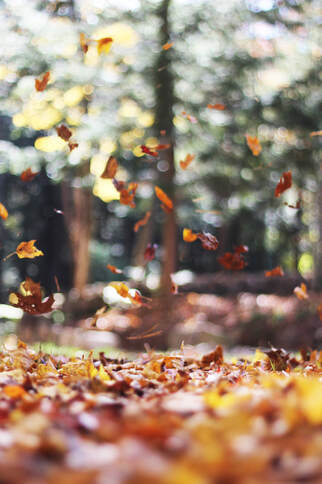 Photo by Autumn Mott Rodeheaver on Unsplash Photo by Autumn Mott Rodeheaver on Unsplash We are deep into autumn, with a chill in the air and the hours of daylight diminishing, prompting leaves to change color and fall to the ground. What actually causes leaves to fall? In Lab Girl, Hope Jahren provides a beautiful description of the science behind falling leaves: If you rake fallen leaves into a pile and then examine them, you will see that each one shows a consummately clean break at the same place near the base of the stem. The fall of leaves is highly choreographed. First the green pigments are pulled back behind the narrow row of cells marking the border between stem and branch. Then, on the mysteriously appointed day, this row of cells is dehydrated and becomes weak and brittle. The weight of the leaves is now sufficient to bend and snap it from the branch. It takes a tree only a week to discard its entire year's work, cast off like a dress barely worn but too unfashionable for further use. Can you imagine throwing away all of your possessions once a year because you are secure in your expectation that you will be able to replace them in a matter of weeks? (p. 95) Autumn's falling leaves offers an opportunity to consider what we can discard. What is it that we no longer need? What is that we don't need now, but are confident we can restore in the future? In what ways are we comfortable or not about letting go? 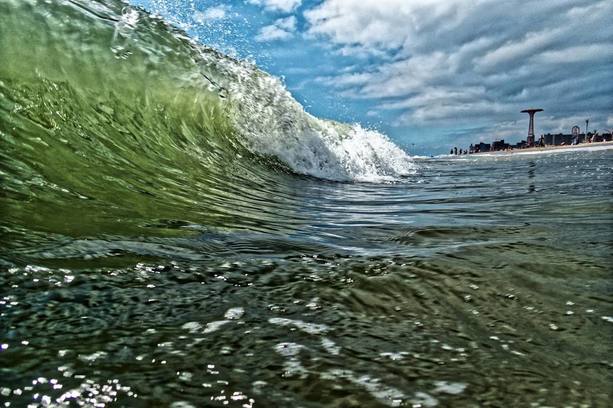 Photo: Jim McDonnell (2018) Photo: Jim McDonnell (2018) Water creates and destroys. It is vital for life, for humans and other animals (we who are mostly water) and for vegetation on which our lives and the lives of almost all other living creatures depend for food and oxygen. It is a source of delight, a tall glass of ice cold water quenching our thirst on a hot day, a cool shower cleansing off the sweat and grit of from a sweltering city day, and a glimpse of a shimmering river, bay or ocean offering a panorama that can fill us with a sense of beauty and awe. Yet, water also annihilates. It turns violent in its machinery of storms, with ravaging hurricanes and wall-of-water tsunamis inundating and destroying homes and possessions and endangering and ending our lives. Over years, water destroys the roofs over our homes. Over eons, it eats away at the land, eroding it to form canyons; as glacial ice, it pushes aside stone, carving grand valleys like giant earth moving equipment. We encounter water-as-destroyer with the arrival of hurricane season, and the 2018 season launched with Florence hitting landfall in the Carolinas this past weekend, swelling rivers, transforming streets into canals, uprooting trees, and destroying homes and lives. Floodwaters continue to rise, with the region’s water supply endangered by contamination from toxic pollutants. Yet, a few hundred miles to the north, with a high pressure system stalling the northward creep of the storm, water was offering its delights to a few dozen swimmers, including myself, participating in an open water event at Coney Island with CIBBOWS, Coney Island Brighton Beach Open Water Swimming, the “Triple Dip”, with options to swim 1, 2, or 3 miles. Despite the devastating conditions in the Carolinas, the conditions at Coney Island were splendid, with air temperature in the mid-seventies and water at a temperature in the low-70s and not unusually turbulent. Swimming at Coney Island offers an experience in contrasts, even separate from markedly different weather systems along the coast. Immersed off the coast in the open water, slicing through modest chop and current, and occasionally bumping into fish, one catches glimpses of the amusement park and its iconic rides: the Cyclone roller coaster, carousel, and Wonder Wheel, looking like giant toys. On the one hand, ocean water, so natural and elemental, and on the other hand, brightly colored attractions built for entertainment. Then again, the water offers its own ride, with wave motion rocking your body and the current redirecting your stroke. But if the amusement park Cyclone was abuzz with activity, so too was a real cyclone, making landfall to the south, and during the day’s swim at Coney Island, the duality of water—like the Hindu god Shiva, destroyer and benefactor—was on many of our minds. After all, it was only 6 years ago that Hurricane Sandy inflicted tens of billions of dollars of devastation in the New York area. Storm surges flooded streets, subways, and tunnels and terminated power for many communities, and we are still experiencing the storm’s effects. The flooded Cortland Street subway station opened just a few weeks ago, and the L train will soon shut down for repairs due to damage incurred from Sandy flooding. Other hurricanes continue to devastate in their aftermath: Maria in Puerto Rico, Harvey in Texas, and Katrina in New Orleans How to reconcile the contrasts in nature? On the one hand, water offered its delights to a group of folks opting for the voluntary adventure of a beach-side open water swim on a sunny day, with a view of a giddy amusement park; yet, a few hundred miles south, water was a force of monstrosity, putting lives at risk. Like the ebb and flow of tides, water gives and takes away. Wind, Water, Stone By Octavio Paz (1979) Translated by Elliot Weinberger Water hollows stone, wind scatters water, stone stops the wind. Water, wind, stone. Wind carves stone, stone's a cup of water, water escapes and is wind. Stone, wind, water. Wind sings in its whirling, water murmurs going by, unmoving stone keeps still. Wind, water, stone. Each is another and no other: crossing and vanishing through their empty names: water, stone, wind. |
About this Blog
Hi! I'm Nancy Kopans, founder of Urban Edge Forest Therapy. Join me on an adventure to discover creative ways to connect with nature in your daily life, ways that are inspired by urban surroundings that can reveal unexpected beauty, with the potential to ignite a sense of wonder. Archives
April 2023
Categories
All
|

 RSS Feed
RSS Feed